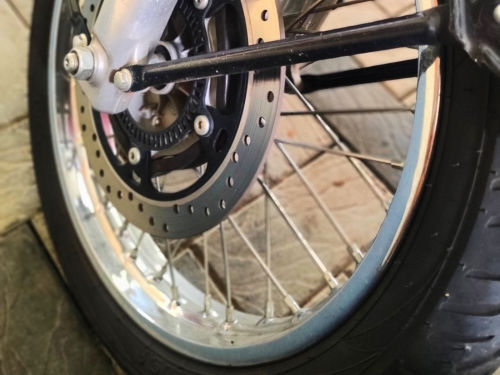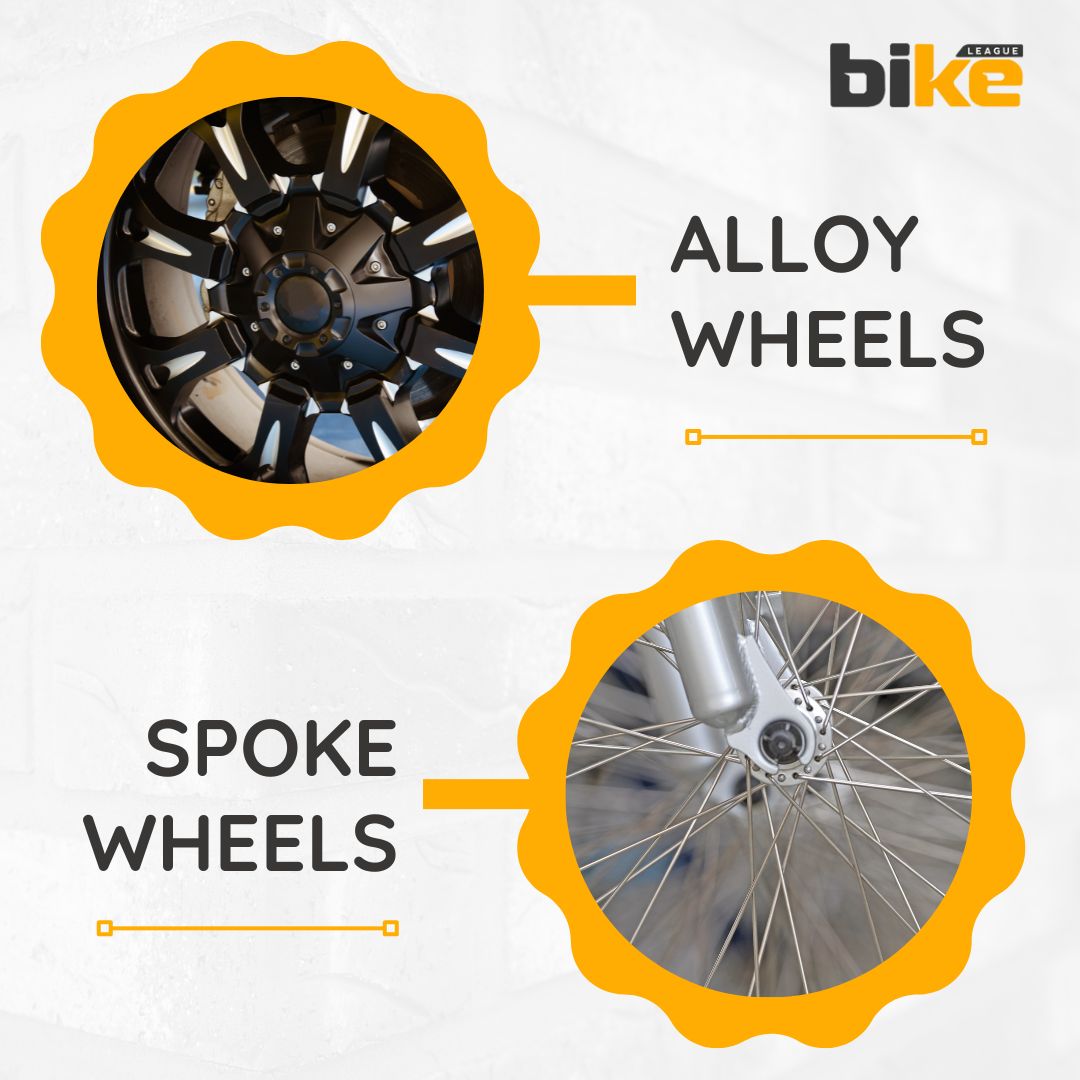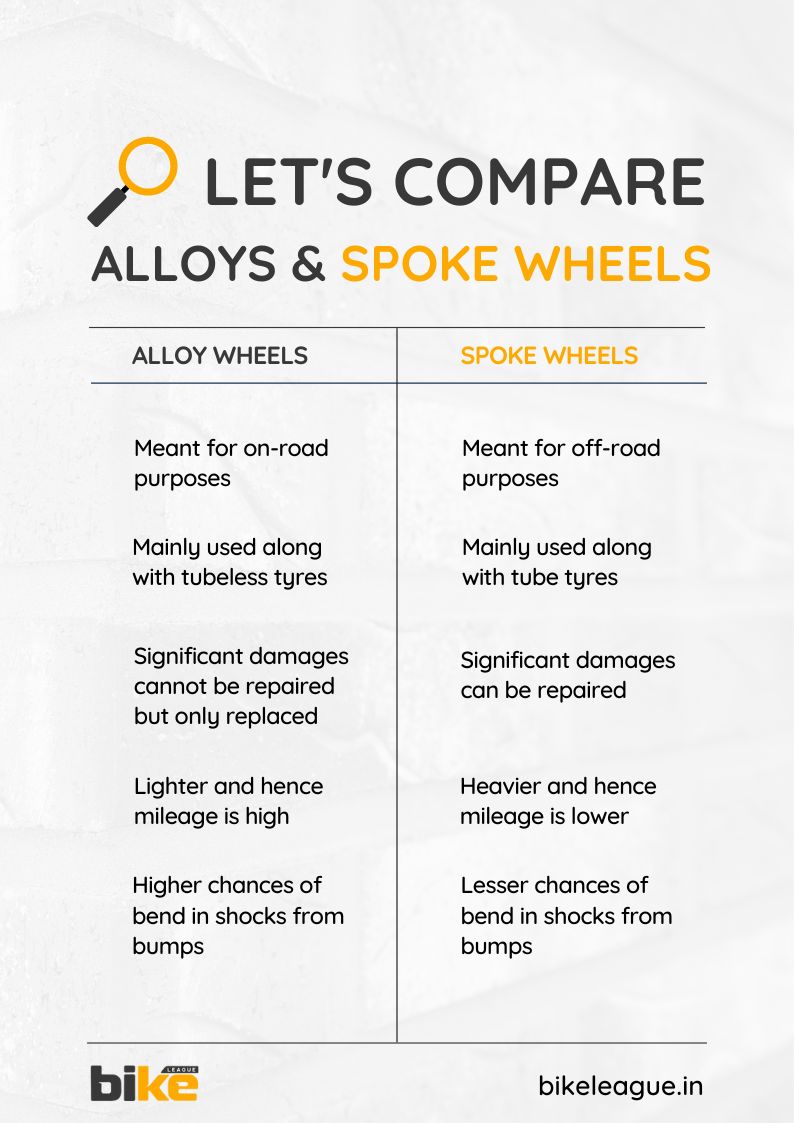
Long story short – Bike Alloy wheels are for on-road purposes. In contrast, bike spoke wheels are for off-road purposes, but what about other features of these motorcycle wheel types?
Wheels are the only thing that comes in contact with the ground in a motorcycle. Yes. What shoes are meant for legs is what wheels are for a bike. It is a significant part of the motorcycle. A wheel is a circular component intended to rotate on an axle bearing. In that, a wheel consists of alloy/spoke along with tyres. In this article, our focus is purely on wheels. Wheel types vary depending on the motorcycle riding conditions, like off-road or on-road. Etc. It’s time to delve deep into the world of circular wheels, and let’s discuss the A-Z of motorcycle wheel types right here.
Motorcycle wheel types
Motorcycle wheels come in various types, each designed to address specific performance needs and riding conditions. Here’s a breakdown of the common types of motorcycle wheels:
- Spoke wheels
- Alloy wheels
Spoke Wheels
These are traditional ones used before the 1970s. These bike spoke wheels made from cast aluminium changed the dynamics of the motorcycling industry as they were low in price, spoke wheels were easy to manufacture, and allowed bikes to run without tubes.
These work on the simple principle of tension. The spokes or wires on the wheel going all crisscross are nothing but the steel wires creating stress on the wheel rim. Spokes help the wheel keep its shape and even take on load on itself.
Advantages of spoke wheels
1. Durability and Flexibility
Spoke wheels are best for their durability and ability to absorb intense impacts, making them ideal for rough terrains and off-road conditions. The individual spokes can bend and flex, which helps in tackling uneven surfaces without breaking.
2. Low Maintenance and Cost
Bike spoke wheels generally require low maintenance and are cheaper to repair or replace than bike alloy wheels. Their design supports bad road conditions, making them cost-effective for adventure and dirt bikes.
3. Shock Absorption
The flexibility of spoke wheels allows them to absorb shocks from bumpy roads, potholes, and debris, reducing the risk of damage to the bike and providing a smoother ride on rough terrains.
4. Suitability for Off-Road Use
Spoke wheels are better suited for off-road use due to their robustness and ability to handle rough conditions. They are commonly found on adventure bikes, motocross machines, and dual-sports.
Disadvantages of Spoke wheels
1. Weight and Performance
These are heavier than alloy wheels, negatively impacting the bike’s performance and fuel efficiency. The increased air drag caused by the spokes can also reduce the bike’s speed and overall efficiency.
2. Maintenance Requirements
The metal spokes are constantly under stress and require regular inspection and adjustment to ensure they remain in good condition. This can be time-consuming and may require specialized tools.
3. Aesthetic and Cleaning Challenges
Spoke wheels have an old-world charm, but they can be challenging to clean due to the narrow spaces between the spokes. This can be a drawback for riders who prioritize the aesthetic appeal of their bikes.
Alloy wheels
Alloy wheels are new-age tubeless wheels designed to provide enhanced performance with more safety. They have changed the wheel manufacturing industry model. Alloys consist of metals like aluminium and magnesium; they are light in weight and, thus, enhance the bike’s performance. An alloy wheel is nonferrous with different metals heated at various levels. Two prominent metals found in most alloy wheels are magnesium and aluminium.
In April 1922, Borrani started the production of motorcycle wheels with an aluminium rim. Although cast wheels had already been used on automobiles previously, it was in 1927 that the Bohme Land, a motorcycle built in Czechoslovakia, was fitted with cast wheels.
Advantages of Alloy wheels
1. Lightweight and Improved Performance
Alloy wheels are lighter than spoke wheels, reducing the bike’s unsprung weight and improving road-holding, fuel economy, and overall performance. Their lightweight nature also supports higher speeds and better handling.
2. Sturdiness and Stability
Alloy wheels are rigid and can handle high torque and horsepower, making them suitable for street and track motorcycles. Their solid construction provides stability and predictability, especially at higher speeds and during cornering.
3. Modern Design and Tubeless Compatibility
Alloy wheels are compatible with tubeless tyres, enhancing the bike’s safety and performance. They also offer sleek and sharp designs that can be customized to match the bike’s aesthetics.
4. Ease of Manufacturing and Repair
Alloy wheels are quickly manufactured with minimal human error. In some cases, they are also easier to repair, although severe damage may require a complete replacement.
Disadvantages of Alloy wheels
1. Susceptibility to Damage
Alloy wheels are less durable than spoke wheels and are more prone to cracks and dents, mainly when used on rough terrains. Their rigid nature makes them less capable of absorbing shocks from bumpy roads.
2. Higher Cost
Alloy wheels are generally more expensive than spoke wheels in terms of initial purchase and replacement costs. This can be a significant consideration for budget-conscious riders.
3. Limited Off-Road Capability
Due to their lack of flexibility and shock absorption, alloy wheels are less suitable for off-road use. They are more likely to become imbalanced and damaged when exposed to rough conditions.
Differences between Motorcycle Alloy wheels & Spoke wheels in various aspects
| Aspect | Alloy Wheels | Spoke Wheels |
|---|---|---|
| Weight & Handling | Generally lighter than steel-rimmed spokes, so you get crisper turn-in, quicker acceleration and braking feel. Ideal for twisty-road and sport riding. | Heavier overall, and spokes add rotating mass farther from the hub, so handling feels a bit more sluggish by comparison. |
| Stiffness & Feedback | Very rigid—transmits road bumps directly into the chassis. Gives precise feedback at the expense of comfort on rough surfaces. | Spokes flex under load, absorbing small bumps and reducing “jarring” on uneven back-roads or trails. |
| Durability & Impact Resistance | Prone to cracking or bending if you hit a deep pothole at speed. Repair typically means swapping in a new rim. | A spoke can straighten or break on a hard impact, but you can usually replace a broken spoke and re-true the wheel roadside. Better for off-road and poor-road conditions. |
| Tubeless Tyres | Native tubeless fitment—easier puncture repair with sealants or plugs, and you avoid inner-tube hassles. | Traditional spokes require tubes; conversion kits exist but add weight and can compromise sealing unless you use special rims with sealed spoke nipples. |
| Heat Dissipation (Braking) | Alloy conducts heat away from brakes, helping to manage fade on long descents. | Steel spokes and rims heat up less efficiently; on long downhill runs you may notice braking performance degrade slightly more. |
What are latest advancements in spoke-wheel technology in motorcycles?
- Tubeless-Ready Spoke Rims – Several manufacturers for e.g. Royal Enfield on the Classic 350, Honda on the H’ness CB350, KTM off-road models now use rims with sealed spoke‐nipple beds. This lets you fit tubeless tyres without inner-tubes, combining the off-road toughness of spokes with the puncture-ease of tubeless setups.
- Stainless-Steel & Double-Butted Spokes – Stainless steel resists corrosion (critical in India’s humid and coastal areas), and double-butted spokes (thicker at ends, thinner mid-span) reduce weight without sacrificing tensile strength.
- Proprietary Sealed Nipples & Low-Maintenance Hubs – Newer kits feature O-ring–sealed spoke nipples that keep dirt and water out, so you can go 10,000 km between full‐wheel truing services in many cases.
- Composite/Carbon Spokes (Premium Segment) – High-end adventure and racing bikes sometimes use carbon-composite struts in lieu of steel spokes—cutting weight by up to 30 % and offering even more predictable flex characteristics. Currently a niche (and costly) option, but it’s trickling from race to road.
- Self-Tensioning Spoke Systems – Experimental designs (still rare in the Indian market) use spring‐loaded nipple housings that automatically maintain spoke tension as wheels heat up, cool down, or flex under load. This promises even less maintenance in the future.
Cost components in both Motorcycle spoke wheels & Alloy Wheels in India
| Cost Component | Alloy Wheels | Spoke Wheels |
|---|---|---|
| Upfront Price | Typically ₹2,500–₹4,500 per wheel (urban commuters through mid-capacity bikes). Higher for multi-piece or “premium” designs. | Basic steel-rimmed spoke wheels start around ₹1,200–₹2,000 per wheel. Even premium stainless-steel spoke sets seldom exceed ₹3,000. |
| Routine Maintenance | Virtually none—just occasional cleaning. | Periodic wheel-truing (every 3,000–5,000km) to keep spokes evenly tensioned; a service job that costs ₹150–₹300. |
| >Repair after Damage | A bent or cracked alloy rim usually must be replaced outright (₹3,000–₹5,000). | Broken spokes can be replaced one-by-one (₹20–₹40 per spoke) and the wheel re-trued for a few hundred rupees. |
FAQs About Motorcycle Spoke and Alloy Wheels
1. What are the main differences between alloy and spoke wheels?
Alloy wheels are made from a single metallic block, typically aluminium or magnesium, and are known for their rigidity and lightweight properties. In contrast, spoke wheels have a rim connected to a hub by several wire spokes, offering more flexibility and durability, especially on rough terrains.
2. Which type of wheel is better for high-speed riding?
Alloy wheels are better suited for high-speed riding due to their rigid structure, providing better handling and corner stability. They can handle higher speeds and more horsepower and torque with ease.
3. Are alloy wheels more durable than spoke wheels?
Spoke wheels are generally more durable than alloy wheels because they can bend and flex to absorb shocks from rough terrains, making them ideal for off-road riding. Alloy wheels, while sturdy, are more susceptible to cracks and dents and often require complete replacement if damaged.
4. Can we use bike alloy wheels with tubeless tyres?
Yes, alloy wheels almost universally allow tubeless tyres to fit, offering advantages such as better stability, cooler running, and easier puncture repair. This is one of the significant benefits of alloy wheels over spoke wheels.
5. What are the maintenance requirements for spoke wheels?
Spoke wheels require regular inspection and adjustment to ensure that each spoke is under the correct tension. This maintenance is crucial to prevent wheel deformation and ensure optimal performance, especially on rough terrains.
6. Are there any weight differences between bike alloy and spoke wheels?
Alloy wheels are generally lighter than spoke wheels, which can improve fuel efficiency and reduce the motorcycle’s unsprung weight, enhancing road-holding capabilities. However, there are varying arguments about the weight differences depending on the specific materials and designs used.
7. What are the cost implications of choosing bike alloy wheels over spoke wheels?
Alloy wheels are typically more expensive than spoke wheels due to the higher quality materials and manufacturing processes. However, they offer modern features like tubeless tyre compatibility and improved performance, which can justify the higher cost for many riders.
8. Which type of wheel is better for off-road riding?
Spoke wheels are better suited for off-road riding because they are more flexible and absorb impacts from rough terrains, reducing the risk of wheel damage. Their durability and ability to handle shocks make them the preferred choice for off-road bikes, scramblers, and adventure motorcycles.
9. What are the aesthetic differences between bike alloy and spoke wheels?
Alloy wheels are available in various designs and colours, offering a modern and stylish look. In contrast, spoke wheels have a traditional design that appeals to riders who prefer a classic or retro aesthetic.
10. What should I consider when choosing between alloy and spoke wheels?
When choosing between alloy and spoke wheels, consider your type of riding, the terrain you frequently encounter, and your maintenance preferences. Alloy wheels are ideal for high-speed, on-road riding with minimal maintenance, while spoke wheels are better for off-road conditions and require regular upkeep.
11. Does the number of spokes in wheels increase ride quality?
The greater the number of spokes, the better strength the wheel gets. But it also affects the overall aerodynamics of the bike. The higher number of spokes creates more wind resistance and a loss of power transmission to the wheels.
12. Are spoke wheels reliable?
First, let’s deduce from your requirements that sturdiness–spoke wheels are much better in terms of reliability. They are repairable and do not crack or lose composure in bumps.
13. Are spokes in spoke wheels replaceable?
A faulty or damaged spoke should be replaced. In a properly built wheel, stainless steel spokes don’t suffer from fatigue, so a fatigue failure can be the first of many. Two or more fatigue failures mean rebuilding the whole wheel with new spokes is the best option.
14. Can spoke wheels and tubeless tyres be used together?
The spoke nipples have a particular gap between the rim, and the spoke tensioner, which would cause leaks if fitted with tubeless tyres. Hence, tubeless tyres couldn’t fit in bike spoke wheels. While there are exceptions in the spoke wheels of superbikes as the spoke nipples are sealed during the manufacturing process.
15. Can we repair damaged alloy wheels?
The user cannot repair damaged alloy wheels; the only option is to replace the damaged one with a new one.
16. Why are tubeless tyres suitable for alloy wheels?
Alloy wheels are perfect for tubeless tyres because of the sitting position of the tyre on the rim. The tyre fits perfectly and accurately on the rim in the periphery, which is very important; improper fitting may cause the bike to start wobbling at the time of riding.
17. Do motorcycle wheels need alignment?
Generally not needed if it is an alloy wheel. But the spoke wheels need alignment.
18. Where to buy motorcycle wheels online?
Always look for motorcycle wheels on the official company website or e-commerce portals like Amazon India or Flipkart. You can refer online for colour options and other details. But never buy online.
19. Should you always buy motorcycle wheels offline?
Yes, without a doubt, you should buy motorcycle wheels offline to check the wheels’ size, quality, and colour and make the final decision only after seeing the wheels. So, always purchase offline.
Other related articles from Bikeleague India
- What is Motorcycle ABS? – Doubts, Queries and FAQ
- How to read two wheeler tyre code and tyre size
- Motorcycle service – All things you need to know explained
- Different types of bike clutch explained
- ADMS DB
Conclusion
From the above discussion, it is evident that there is no one-size-fits-all when debating which wheels are better, motorcycle spokes type or alloy. Given a chance, I would choose an alloy wheel because the tubeless tyre is lighter, and fixing a puncture on a tubeless tyre is much faster and simpler. It is more accessible than dealing with an inner tube.
But if you want hardcore off-roading, you should opt for spoke wheels. Rims, spokes, hubs, and a tube might make it heavier. Fixing it, too, can be a pain, but at least if you manage to damage the wheel, you won’t have to replace the entire wheel, just one small part unwillingly.
For example, in theory, if you dent a rim, you can unbend a rim or replace the rim without really touching the spokes or the hub. You can even replace one spoke at a time if you break spokes. If you break a hub-
which is very rare; you can replace the hub without touching the rest of the wheel.
So, for the more performance-oriented road bikes – you should choose cast-alloy wheels because cast wheels are easier to make. They are more consistent in their performance, and you get better feedback. But when you start talking about off-roader motorcycles that go into difficult conditions, you should go with spoke wheels because they are easier to fix and deal with uneven roads well.
If you have any other doubts or queries, email us at bikeleague2017@gmail.com. You can also share your doubts or opinions in the comments section below. We are always eager to help and assist you. Also, here are several social media platforms of Bikeleague India to raise your suspicions.




